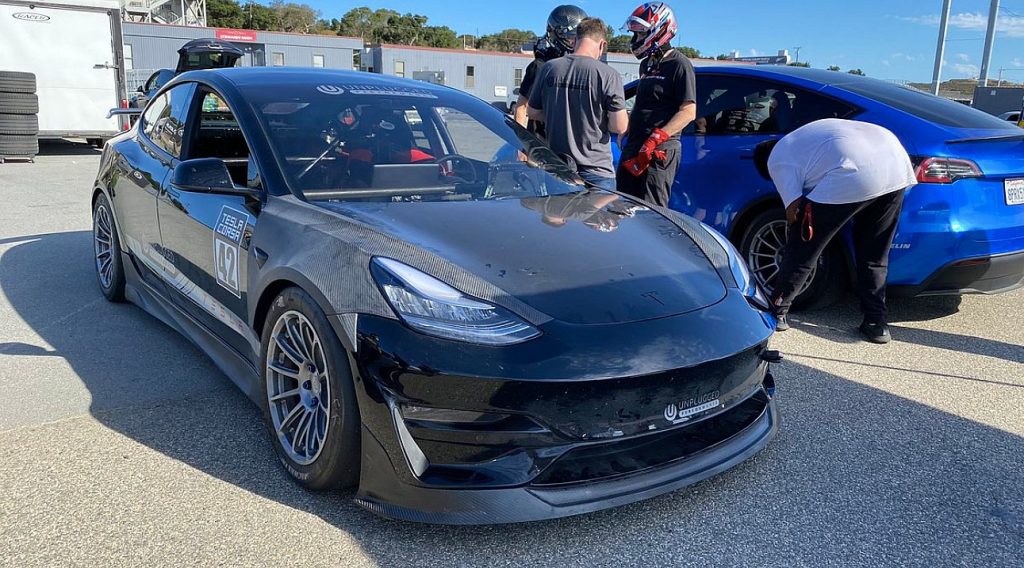

News
Tesla Model 3 driven by the father of Track Mode breaks Plaid Model S’ lap record
Last year, Tesla shocked the electric vehicle world when it revealed that it had a Plaid Model S prototype that could be taken and pushed to its limits at the track. The vehicle, which was driven by a member of the Tesla development team, absolutely crushed the previous records set by four-door sedans at Laguna Seca, completing the tricky course in just 1:36.555.
This record, set by the formidable Plaid Model S, has now been broken. Surprisingly enough, the record was actually beaten by an upgraded version of its little brother, the Model 3 Performance. The Model 3 Performance definitely lacked the raw power of the tri-motor Model S, but it sure made up for it with clever mods and a master driver behind the wheel. The Model 3’s driver was Randy Pobst, a professional racer driver and, in a way, the father of Track Mode.
Back in October 2018, the Tesla Model 3’s development version of Track Mode was driven by Pobst against the Jaguar I-PACE EV400 and one of the best ICE cars available then, the Alfa Romeo Giulia Quadrifoglio. The development version of Track Mode performed well, and it toppled the I-PACE EV400 easily enough. It was, however, not enough to beat the Alfa Q4. Tesla then spent the next weeks working with Pobst to refine Track Mode’s setting and features, which were later rolled out as the release version of the special setting. With Track Mode’s release version, the Model 3 Performance was able to crush the Alfa Romeo Q4’s time easily.
Perhaps it is this experience and his intimate knowledge of the Model 3 Performance’s capabilities that allowed Randy Pobst to push the all-electric sedan to its absolute limits. Or perhaps it is the vehicle’s modifications from EV tuning house Unplugged Performance, which equipped the vehicle with both consumer and prototype parts from its Ascension-R package. Either way, the Model 3, driven by the driver who tuned its BMW M3-killing feature, completed a lap around the Laguna Seca raceway in 1:35.790.
What is even more interesting is that the Model 3 Performance was not specifically tuned for Laguna Seca. The vehicle is actually being prepared for the Pikes Peak Hill Climb, so its runs at Laguna Seca were simply a way to test the vehicle’s capabilities. The Model 3 even had a weight penalty during its record-breaking run, since it was equipped with a 160-lb roll cage that was mandatory for Pikes Peak. Even Pobst himself only flew in from the East Coast for 24 hours to test the vehicle.
In a statement to Teslarati, Unplugged Performance CEO Ben Schaffer expressed his excitement at the results of the Model 3 Performance’s Plaid-breaking lap. “Our expectations at Laguna Seca were simply to validate the car with Randy and to make sure we are safely dialed in for Pikes Peak. It definitely shocked us all when we beat the lap time of the mighty Plaid Model S prototype in our Model 3. The crazy thing is that we still have a lot of additional modifications being prepared and we’ve not come near the car’s full potential with our upgrades yet!” he said.

Now, one has to imagine just how fast the Plaid Model S could go around Laguna Seca with a professional driver like Randy Pobst behind its wheel. That run would likely be one for the books.

News
Tesla FSD v14.2.2 is getting rave reviews from drivers
So far, early testers have reported buttery-smooth drives with confident performance, even at night or on twisty roads.

Tesla Full Self-Driving (Supervised) v14.2.2 is receiving positive reviews from owners, with several drivers praising the build’s lack of hesitation during lane changes and its smoother decision-making, among others.
The update, which started rolling out on Monday, also adds features like dynamic arrival pin adjustment. So far, early testers have reported buttery-smooth drives with confident performance, even at night or on twisty roads.
Owners highlight major improvements
Longtime Tesla owner and FSD user @BLKMDL3 shared a detailed 10-hour impression of FSD v14.2.2, noting that the system exhibited “zero lane change hesitation” and “extremely refined” lane choices. He praised Mad Max mode’s performance, stellar parking in locations including ticket dispensers, and impressive canyon runs even in dark conditions.
Fellow FSD user Dan Burkland reported an hour of FSD v14.2.2’s nighttime driving with “zero hesitations” and “buttery smooth” confidence reminiscent of Robotaxi rides in areas such as Austin, Texas. Veteran FSD user Whole Mars Catalog also demonstrated voice navigation via Grok, while Tesla owner Devin Olsen completed a nearly two-hour drive with FSD v14.2.2 in heavy traffic and rain with strong performance.
Closer to unsupervised
FSD has been receiving rave reviews, even from Tesla’s competitors. Xpeng CEO He Xiaopeng, for one, offered fresh praise for FSD v14.2 after visiting Silicon Valley. Following extended test drives of Tesla vehicles running the latest FSD software, He stated that the system has made major strides, reinforcing his view that Tesla’s approach to autonomy is indeed the proper path towards autonomy.
According to He, Tesla’s FSD has evolved from a smooth Level 2 advanced driver assistance system into what he described as a “near-Level 4” experience in terms of capabilities. While acknowledging that areas of improvement are still present, the Xpeng CEO stated that FSD’s current iteration significantly surpasses last year’s capabilities. He also reiterated his belief that Tesla’s strategy of using the same autonomous software and hardware architecture across private vehicles and robotaxis is the right long-term approach, as it would allow users to bypass intermediate autonomy stages and move closer to Level 4 functionality.
News
Elon Musk’s Grok AI to be used in U.S. War Department’s bespoke AI platform
The partnership aims to provide advanced capabilities to 3 million military and civilian personnel.

The U.S. Department of War announced Monday an agreement with Elon Musk’s xAI to embed the company’s frontier artificial intelligence systems, powered by the Grok family of models, into the department’s bespoke AI platform GenAI.mil.
The partnership aims to provide advanced capabilities to 3 million military and civilian personnel, with initial deployment targeted for early 2026 at Impact Level 5 (IL5) for secure handling of Controlled Unclassified Information.
xAI Integration
As noted by the War Department’s press release, GenAI.mil, its bespoke AI platform, will gain xAI for the Government’s suite of tools, which enable real-time global insights from the X platform for “decisive information advantage.” The rollout builds on xAI’s July launch of products for U.S. government customers, including federal, state, local, and national security use cases.
“Targeted for initial deployment in early 2026, this integration will allow all military and civilian personnel to use xAI’s capabilities at Impact Level 5 (IL5), enabling the secure handling of Controlled Unclassified Information (CUI) in daily workflows. Users will also gain access to real‑time global insights from the X platform, providing War Department personnel with a decisive information advantage,” the Department of War wrote in a press release.
Strategic advantages
The deal marks another step in the Department of War’s efforts to use cutting-edge AI in its operations. xAI, for its part, highlighted that its tools can support administrative tasks at the federal, state and local levels, as well as “critical mission use cases” at the front line of military operations.
“The War Department will continue scaling an AI ecosystem built for speed, security, and decision superiority. Newly IL5-certified capabilities will empower every aspect of the Department’s workforce, turning AI into a daily operational asset. This announcement marks another milestone in America’s AI revolution, and the War Department is driving that momentum forward,” the War Department noted.
News
Tesla FSD (Supervised) v14.2.2 starts rolling out
The update focuses on smoother real-world performance, better obstacle awareness, and precise end-of-trip routing, among other improvements.

Tesla has started rolling out Full Self-Driving (Supervised) v14.2.2, bringing further refinements to its most advanced driver-assist system. The new FSD update focuses on smoother real-world performance, better obstacle awareness, and precise end-of-trip routing, among other improvements.
Key FSD v14.2.2 improvements
As noted by Not a Tesla App, FSD v14.2.2 upgrades the vision encoder neural network with higher resolution features, enhancing detection of emergency vehicles, road obstacles, and human gestures. New Arrival Options let users select preferred drop-off styles, such as Parking Lot, Street, Driveway, Parking Garage, or Curbside, with the navigation pin automatically adjusting to the user’s ideal spot for precision.
Other additions include pulling over for emergency vehicles, real-time vision-based detours for blocked roads, improved gate and debris handling, and extreme Speed Profiles for customized driving styles. Reliability gains cover fault recovery, residue alerts on the windshield, and automatic narrow-field camera washing for new 2026 Model Y units.
FSD v14.2.2 also boosts unprotected turns, lane changes, cut-ins, and school bus scenarios, among other things. Tesla also noted that users’ FSD statistics will be saved under Controls > Autopilot, which should help drivers easily view how much they are using FSD in their daily drives.
Key FSD v14.2.2 release notes
Full Self-Driving (Supervised) v14.2.2 includes:
- Upgraded the neural network vision encoder, leveraging higher resolution features to further improve scenarios like handling emergency vehicles, obstacles on the road, and human gestures.
- Added Arrival Options for you to select where FSD should park: in a Parking Lot, on the Street, in a Driveway, in a Parking Garage, or at the Curbside.
- Added handling to pull over or yield for emergency vehicles (e.g. police cars, fire trucks, ambulances).
- Added navigation and routing into the vision-based neural network for real-time handling of blocked roads and detours.
- Added additional Speed Profile to further customize driving style preference.
- Improved handling for static and dynamic gates.
- Improved offsetting for road debris (e.g. tires, tree branches, boxes).
- Improve handling of several scenarios, including unprotected turns, lane changes, vehicle cut-ins, and school buses.
- Improved FSD’s ability to manage system faults and recover smoothly from degraded operation for enhanced reliability.
- Added alerting for residue build-up on interior windshield that may impact front camera visibility. If affected, visit Service for cleaning!
- Added automatic narrow field washing to provide rapid and efficient front camera self-cleaning, and optimize aerodynamics wash at higher vehicle speed.
- Camera visibility can lead to increased attention monitoring sensitivity.
Upcoming Improvements:
- Overall smoothness and sentience.
- Parking spot selection and parking quality.








